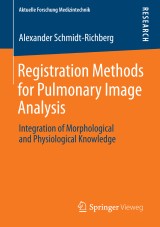Details

Registration Methods for Pulmonary Image Analysis
Integration of Morphological and Physiological KnowledgeAktuelle Forschung Medizintechnik - Latest Research in Medical Engineering
|
53,49 € |
|
| Verlag: | Springer Vieweg |
| Format: | |
| Veröffentl.: | 28.01.2014 |
| ISBN/EAN: | 9783658016623 |
| Sprache: | englisch |
| Anzahl Seiten: | 168 |
Dieses eBook enthält ein Wasserzeichen.
Beschreibungen
<p>Various applications in the field of pulmonary image analysis require a registration of CT images of the lung. For example, a registration-based estimation of the breathing motion is employed to increase the accuracy of dose distribution in radiotherapy. Alexander Schmidt-Richberg develops methods to explicitly model morphological and physiological knowledge about respiration in algorithms for the registration of thoracic CT images. The author focusses on two lung-specific issues: on the one hand, the alignment of the interlobular fissures and on the other hand, the estimation of sliding motion at the lung boundaries. He shows that by explicitly considering these aspects based on a segmentation of the respective structure, registration accuracy can be significantly improved.</p>
Registration.- Segmentation.- Level Set Segmentation.- Motion Estimation.- Sliding Motion.- Integrated Registration and Segmentation.
<p>Alexander Schmidt-Richberg works as a research scientist with a focus on image registration and segmentation. He received his PhD at the Institute of Medical Informatics, University of Lübeck, Germany, in 2013. Currently, he is a member of the Biomedical Image Analysis Group, Imperial College London, UK.</p>
<p>Various applications in the field of pulmonary image analysis require a registration of CT images of the lung. For example, a registration-based estimation of the breathing motion is employed to increase the accuracy of dose distribution in radiotherapy. Alexander Schmidt-Richberg develops methods to explicitly model morphological and physiological knowledge about respiration in algorithms for the registration of thoracic CT images. The author focusses on two lung-specific issues: on the one hand, the alignment of the interlobular fissures and on the other hand, the estimation of sliding motion at the lung boundaries. He shows that by explicitly considering these aspects based on a segmentation of the respective structure, registration accuracy can be significantly improved.</p><p> </p><p><b>Contents</b></p><p>· Registration</p><p>· Segmentation</p><p>· Level Set Segmentation</p><p>· Motion Estimation</p><p>· Sliding Motion</p><p>· Integrated Registration and Segmentation</p><p> </p><p><b>Target Groups</b></p><p>· Researchers and students of medical informatics, medical imaging</p><p>· Radiologists, physicians</p><p> </p><p> </p><p><b>The Author</b></p><p>Alexander Schmidt-Richberg works as a research scientist with a focus on image registration and segmentation. He received his PhD at the Institute of Medical Informatics, University of Lübeck, Germany, in 2013. Currently, he is a member of the Biomedical Image Analysis Group, Imperial College London, UK.</p><p> </p><p><b>Editors</b></p><p>The series Aktuelle Forschung Medizintechnik is edited by Thorsten Buzug.</p>
Publication in the field of natural sciences? Includes supplementary material: sn.pub/extras
<p>Various applications in the field of pulmonary image analysis require a registration of CT images of the lung. For example, a registration-based estimation of the breathing motion is employed to increase the accuracy of dose distribution in radiotherapy. Alexander Schmidt-Richberg develops methods to explicitly model morphological and physiological knowledge about respiration in algorithms for the registration of thoracic CT images. The author focusses on two lung-specific issues: on the one hand, the alignment of the interlobular fissures and on the other hand, the estimation of sliding motion at the lung boundaries. He shows that by explicitly considering these aspects based on a segmentation of the respective structure, registration accuracy can be significantly improved.</p>
Diese Produkte könnten Sie auch interessieren:

From Combinatorics to Philosophy

von: Ernesto Damiani, Ottavio D'Antona, Vincenzo Marra, Fabrizio Palombi

149,79 €















